Vintage Treasures: Tuf Voyaging by George R.R. Martin
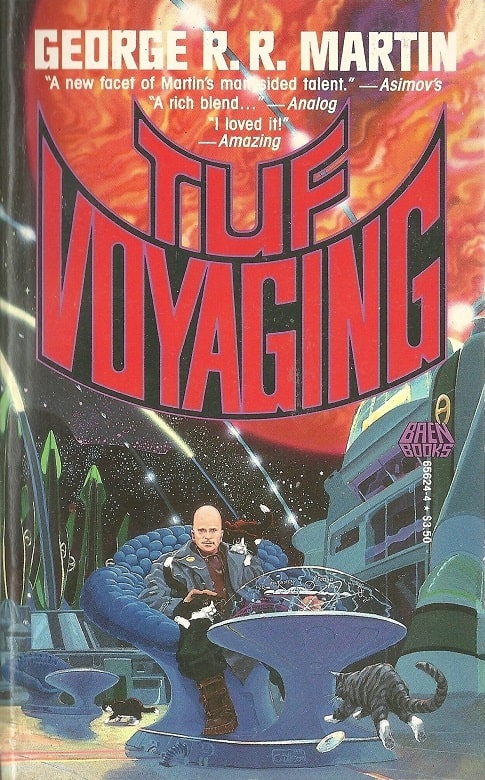 |
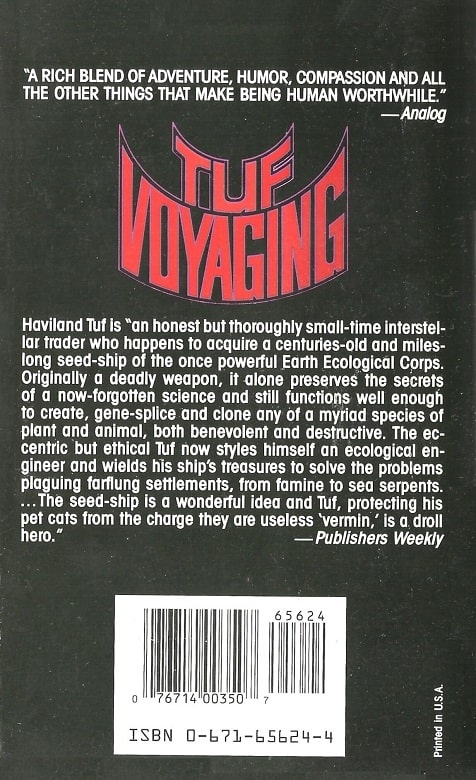 |
Tuf Voyaging (Baen, February 1986). Cover by David Willson
George R.R. Martin is the most successful living American science fiction and fantasy writer. He mostly gets attention for his novels these days, but early in his career he was chiefly known for his wonderfully moody and imaginative short stories, most of which were set in his sprawling Thousand Worlds universe, including the novel Dying of the Light and the famous stories “Sandkings,” “Nightflyers,” “A Song for Lya,” and “The Way of Cross and Dragon.”
Many of Martin’s most ardent fans are unaware of his Thousand Worlds series featuring Haviland Tuf, a small time merchant who inadvertently comes into possession of one of the greatest weapons in the galaxy, a 30-kilometer long seedship known as the Ark. Inspired by the work of the great Jack Vance (and written in a style that sometimes imitates Vance), the tales garnered a number of major award nominations, and were collected in Tuf Voyaging by Baen in 1986.
[Click the images to see tougher versions.]
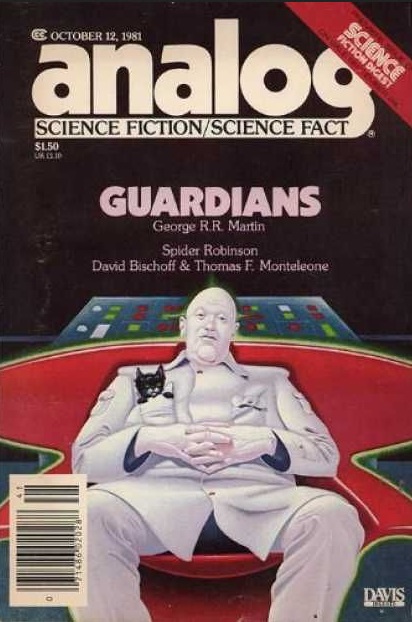 |
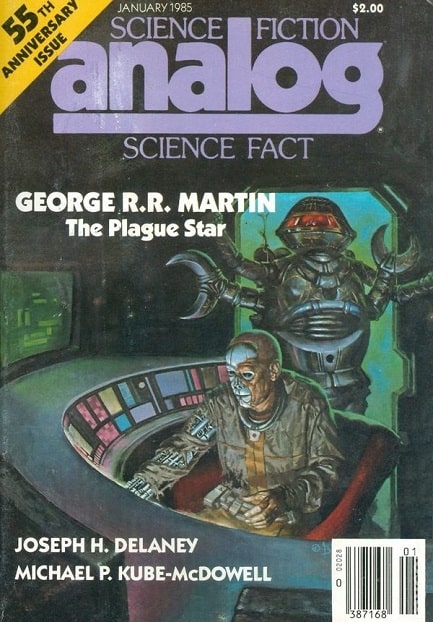 |
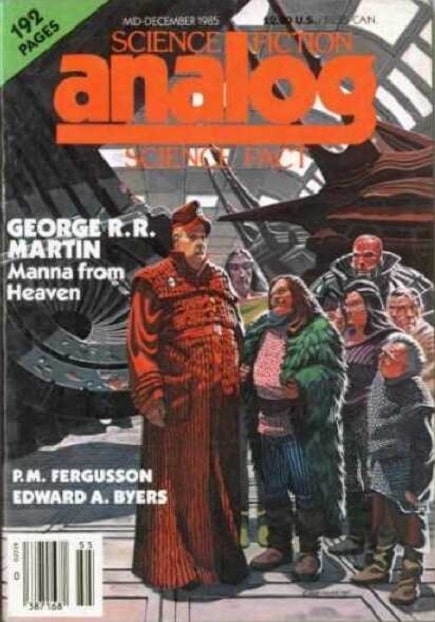 |
Tuf was a familiar sight on the cover of Analog magazine in the 80s: October 1981, January 1985,
and mid-December 1985. Covers by Robert Crawford, Doug Beekman, and Janet Aulisio
Most of the Tuf tales appeared in Analog magazine between 1978-85, with three in 1985 alone.
In a 2001 interview with Nick Gevers, Martin discussed Vance’s influence on these stories.
One of speculative fiction’s most versatile writers, and one of its most naturally talented storytellers, George R. R. Martin is a Romantic if ever there was one. His early stories, many of which fit into a common Future History of galactic desolation, soon attracted notice by reason of their moody bleak poeticism, their rich infusion of Horror into science-fictional templates
Nick Gevers: Looking back at the space operas you produced early in your career, two related features stand out: intense Romanticism, and melancholy Gothicism… You’ve frequently expressed admiration for Jack Vance. How Vancean is A Song of Ice and Fire in conception and style? In particular, does the narrative thread featuring the exotic wanderings of Daenerys Targaryen function in part as a tribute to Vance, to his picaresque inventiveness?
GRRM: Jack Vance is the greatest living SF writer, in my opinion, and one of the few who is also a master of Fantasy. His The Dying Earth (1950) was one of the seminal books in the history of modern Fantasy, and I would rank him right up there with Tolkien, Dunsany, Leiber, and T.H. White as one of the fathers of the genre.
All that being said, I don’t think A Song of Ice and Fire is particularly Vancean. Vance has his voice and I have mine. I couldn’t write like Vance even if I tried… and I did try, once. The first Haviland Tuf story, “A Beast for Norn,” was my attempt to capture some of Vance’s effects, and Tuf is a very Vancean hero, a distant cousin to Magnus Ridolph, perhaps. But what that experiment taught me was that only Jack Vance can write like Jack Vance.
Wikipedia has a fine summary of Tuf Voyaging, including individual summations for the stories.
This novel is a collection of related short fiction works, originally published over several years, beginning with 1976’s “A Beast for Norn.” The book includes a prologue and Martin’s S’uthlam storyline (published in Analog Science Fiction and Fact), adding them as bridging material, and gathering them with other Tuf stories into one episodic novel.
The novel concerns the (mis)adventures of Haviland Tuf, an exceptionally tall, bald, very pale, overweight, phlegmatic, vegetarian, cat-loving-but-otherwise solitary space trader. Tuf inadvertently becomes the master of the Ark, an ancient, 30-kilometre-long (19 mi) “seedship” – a very powerful warship with advanced ecological engineering capabilities – after a deal between several of his venal and cutthroat passengers goes awry. Tuf travels the galaxy, offering his services to worlds with environmental problems, and sometimes imposing solutions of his own…
Martin cited fantasy fiction and science fiction Grand Master Jack Vance as having a large influence on his Tuf stories, and he emulated Vance’s writing style in most of them.
Read the complete summary here.
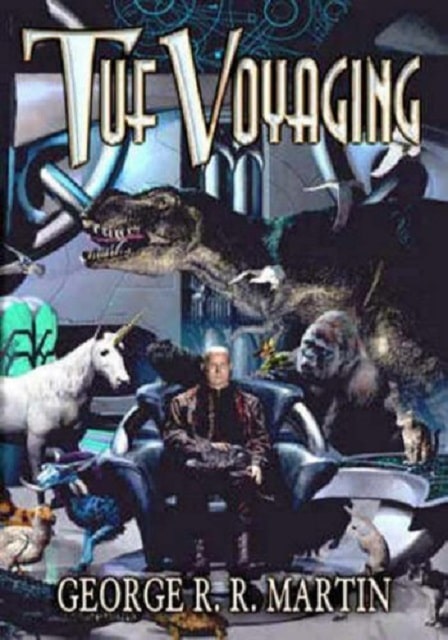 |
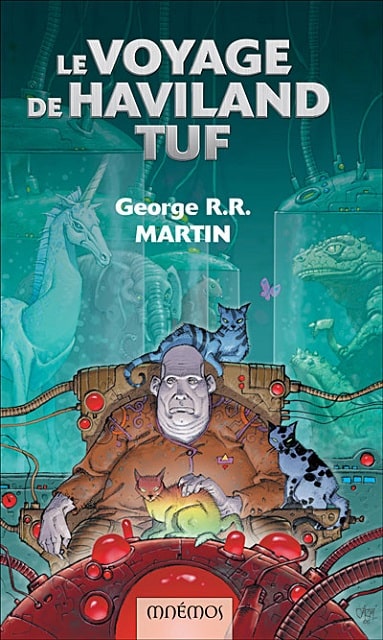 |
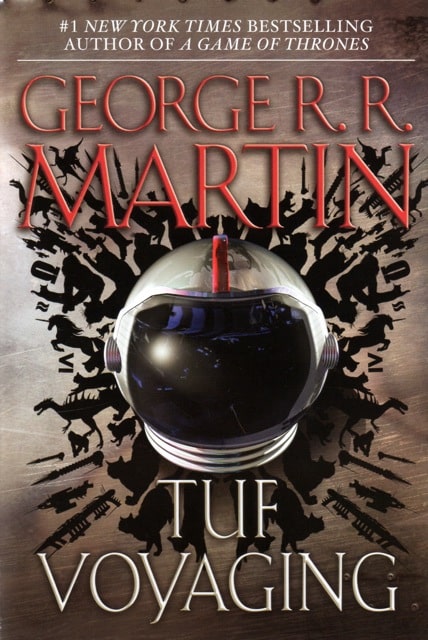 |
More recent editions of Tuf Voyaging: Meisha Merlin (2003), Mnémos (French edition, 2006),
and Bantam Books (2013). Covers by Michael Komarck, Philippe Caza, and Patrick Knowles
Tuf Voyaging was reprinted in hardcover by Meisha Merlin in 2003, and by Bantam Books in 2013.
Cover artists just seem to love depicting Tuf at his command console with a cat in his lap. My favorite is Philippe Caza’s rendition for the 2007 French edition, Le voyage de Haviland Tuf. You know you want to follow the galactic adventures of that laid back guy.
A decade ago Charlie Jane Anders wrote the finest modern appreciation of the tales of Haviland Tuf at Gizmodo, in “This George R.R. Martin Book Might Restore Your Faith in Human Nature.”
Still depressed after the horrible events of Game of Thrones season three, or of George R.R. Martin’s original books? The misery, the misanthropy, the savage reversals of fortune? George R.R. Martin himself has the cure. His funny, strange space opera book Tuf Voyaging has recently been reissued, after a decade out of print… it’s a very different sort of book than Martin’s A Song of Ice and Fire series, although there’s still plenty of the hallmarks of Martin’s wit and clever world-building. Tuf Voyaging is funny and mostly pretty cheerful, although it takes a somewhat darker turn towards the end that might catch you off guard. It’s actually somewhat reminiscent of Harry Harrison at his best — a jaunty, slightly barbed story of space adventure.
The main [character] of Tuf Voyaging is Haviland Tuf, a ginormous bald man with incredibly pale skin and a distinctively fussy, somewhat literal way of speaking — Tuf’s version of wit is to be incredibly dry and straightforward, with a large dose of sarcasm. In fact, his slightly formal speeches, his long-suffering manner, and his massive bulk all remind me a bit of Nero Wolfe, the great detective from Rex Stout’s classic novels…
In the stories of Tuf Voyaging, Tuf is a poor merchant whose fortunes have taken a turn for the worse. And then he’s hired by a motley bunch of prospectors, academics, mercenaries and fortune seekers, who have come across an amazing lost treasure and need to hire Tuf’s ship to get to it. That lost treasure turns out to be the Ark, a long-lost ship of the Ecological Engineering Corps, which had the power to transform worlds — or unleash terrible biological warfare and wipe out entire planets.
Soon enough, Tuf is taking this crew to the Ark, and it doesn’t take long for everyone to start double-crossing each other at amazing speed. This first story sets the slightly comedic, adventurous tone for the rest of the series, although the other stories in the book are increasingly cerebral and less focused on action and adventure.
Tuf never stops being a fascinating hero, though — he’s originally framed as being the only honest man left in a galaxy of scoundrels, which doesn’t stop him from being crafty and outthinking all his opponents. He’s honorable to a fault, and never lies. If he says he’ll do something, he does exactly that. And he never takes advantage of people — except that he always winds up getting the upper hand, and he often allows people to trick themselves. He’s so honest, he’s able to manipulate people using their own greed and stupidity. That’s sort of the basic idea of Tuf’s character, and it’s a brilliant one — but as the book goes on, Martin starts making the situation more complicated. You can tell Martin was having loads of fun writing these stories, which are chock full of little shout-outs and in-jokes…
Three of the stories in the book, or about half its pages, have to do with the planet S’uthlam, whose ginormous population is constantly facing starvation because it’s a Malthusian nightmare — most of the planet’s population believes that humans have a duty to breed as much as possible, because their religion teaches that unlimited procreation will speed up human evolution and allow us to achieve transcendence. Every time Tuf encounters the S’uthlamites, their situation has gotten worse because of this religion — but what right does he have to tell other people not to have children, or to abandon their religious beliefs?
We see the story of S’uthlam mostly through the lens of Tuf’s relationship with Tolly Mune, the portmaster of S’uthlam’s main space port, who doesn’t believe in the planet’s religion but respects the realities of her own world’s politics. She and Tuf keep butting heads, even as she tries to use Tuf’s abilities to help her people. Notably, by the end of the book, we’re completely seeing the encounters between Mune and Tuf through Mune’s eyes, probably because Martin wants us to question the morality of Tuf’s actions the way she does…
The book is often laugh-out-loud funny, largely thanks to Tuf’s dry wit…. Without giving too much away, the fact that the ship Tuf finds in the first story is an ecological engineering vessel turns out to be very significant. First, because it allows Martin to open up questions of power and whether powerful people ought to be able to impose their own ideas on others. But also, second, because it leads to some knotty dilemmas around the notion of ecology… The more you tinker, the more problems you risk causing — and a lot of the most fascinating ideas in Tuf Voyaging come from this question.
The whole thing is well worth reading; check it out here.
Tuf Voyaging contains three long novellas (“The Plague Star,” “Loaves and Fishes,” and “Manna from Heaven”), the Hugo award nominee “Guardians,” and a much expanded version of the very first Tuf story, “A Beast for Norn.” Here’s the complete TOC.
Prologue
“The Plague Star” (Analog Science Fiction/Science Fact, January 1985) — Locus Award nominee
“Loaves and Fishes” (Analog Science Fiction/Science Fact, October 1985) — Analog Award winner
“Guardians” (Analog Science Fiction/Science Fact, October 12, 1981) — Hugo nominee, Locus Award winner
“Second Helpings” (Analog Science Fiction/Science Fact, November 1985)
“A Beast for Norn” (Andromeda, 1976)
“Call Him Moses” (Analog Science Fiction/Science Fact, February 1978)
“Manna from Heaven” (Analog Science Fiction/Science Fact, Mid-December 1985) — Analog Award nominee
Tuf Voyaging was published by Baen in hardcover in February 1986, and reprinted in paperback in March 1987. It is 376, priced at $3.50 in paperback. The cover is by David Willson. A digital edition was released by Bantam in 2013.
See all our recent Vintage Treasures here.
Though I have enjoyed all of Martin’s fiction, his short fiction such as “With Morning Comes Mistfall” and “A Song for Lya” were the stories which had the most impact on me. I never made the connection between Martin and Vance before, but once said it does seem apparent.
On a side note, my first knowledge of Martin was from a Science Fact article he wrote in the August 1972 issue of Analog on computer chess. And yes, I was a chess geek in high school !
I started reading ANALOG in high school as well (in 1977) and the science articles mostly went over my head. But I was definitely a chess geek!
My favorite Martin stories are “Sandkings” and “NIghtflyers,” which I consider high water marks of science fiction horror. Martin hasn’t written much short fiction in the past 20 years, and that’s directly a result of the runaway success of his novels. But who knows — maybe he’ll return to it someday.
Ok, but I just want to know what is going on with that sequel to Robots of Gotham? Five years, Todd.
Thanks for asking!
The sequel to The Robots of Gotham, tentatively titled The Ghost of Navy Pier, is about half done. My editor, John Joseph Adams, published the first chapter in Lightspeed magazine a while back, in which Barry and Zircon Border go up against a 60-ton killer robot hiding in Lake Michigan:
https://www.lightspeedmagazine.com/fiction/the-ambient-intelligence/
Further work on the book was interrupted last year when I was hired to work for a LA production company. However, I hope to pick it up in about two months.
I appreciate the interest very much. 🙂
So is Tuf like Brunner’s The Traveler in Black but in space? Or is that too fanciful a comparison?
Paul,
No, I think it’s very apt. As Charlie Jane Anders puts it:
> Tuf never stops being a fascinating hero… [he’s] crafty and outthinking all his opponents.
> He’s honorable to a fault, and never lies. If he says he’ll do something, he does exactly that…
> And he never takes advantage of people — except that he always winds up getting the
> upper hand… he’s able to manipulate people using their own greed and stupidity.
> That’s sort of the basic idea of Tuf’s character.
That description could almost be applied verbatim to John Brunner’s Traveler in Black, although if I recall correctly the Traveler was more disciplined of purpose, and could be a little more sneaky in bringing justice to the stupid and the venal.
While I’m not a fan of Martin’s “Song of Ice and Fire” novels, I’ve always enjoyed his shorter fiction, Tuf Voyaging included. The first Analog I ever read was the July 1975 issue (a gift from my sister when I was in the hospital) and the cover story was for “And Seven Times Never Kill Man” by Martin, with a really cool John Schoenherr cover. The cover alone made me want to read the story as the aliens were so awesome looking.
I was an Analog subscriber in 1985, and I remember the “early” Tuf stories very well, especially the “pilot” story “The Plague Star”, with the increasing megalomania of the guy in the lobster-claw powered suit, depicted in the cover illustration. It did not end well for him. I never picked up the collected fix-up novel, so I probably should go seek it out. Sigh.